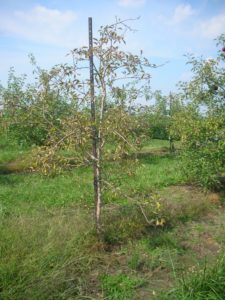A black swan refers to an event that defies expectation and that would be extremely difficult to predict. This spring is one of those. And although it seems unlikely that we will emerge from our last frost-free date (May 15 here in Tippecanoe County) unscathed, it could happen and then you could end up with a lot of scabby fruit if you didn’t start spraying! Scab spores already flying here: Be sure that you have started those early season sprays—and continue them. Less expensive options include captan, manzob and copper, which will provide adequate protection and keep inoculum levels low until we are more certain about the state of our crops.
Pruning to remove diseased wood from last year is a great way to begin your 2016 disease management. If you haven’t already, remove prunings from orchard. If you haven’t finished pruning out and removing any fire blight or cankered wood, you should be making an extra effort now. One more reminder: In case it hasn’t been said already, be sure to calibrate all your spray equipment.
It is probably still too early in most of the state, but start monitoring for apple scab.
In addition to pruning out any overwintering inoculum, a late, dormant application of copper can be used on almost all tree fruit (apple, peach, cherry, plum etc.) to help control a variety of diseases (fire blight, apple scab, peach leaf curl, bacterial canker, black knot, etc.). This is not a silver bullet (remember, it’s copper!) but it does work to knock back fire blight and protect against scab.
Copper comes in many forms-oxides, hydroxides, sulfates, linked to fatty acids–the list is long! There are approximately 40 different labeled copper fungicides, so it is difficult to generalize. Most “dormant” copper products applied at or near bud-break are “fixed coppers” that have low solubility in water. After application, these copper particles slowly release copper ions over time, providing continued protection…and continued risk of phytotoxicity if weather suddenly warms and we go from silver tip to tight cluster to pink in a matter of days. Since this is Indiana, I would caution anyone from using the highest rates of copper, especially finely ground coppers that have the ability to stick around, and could result in fruit russetting on early flowering varieties.
Where apples are just beginning to show green-tip, it is definitely time for protective fungicides such captan or EBDCs, especially if you skipped the copper. Remember, you want that first spray for scab management to go on before the first infection period—in other words, once green tissue is visible you need to be protecting it! How to decide which one to use depends upon the stage of growth and the weather. If you are still at silver or not yet at half-inch green, consider using copper, to knock back the bacteria that cause fire blight, while providing scab control, too. An early application of copper is as effective 3 lbs/acre of mancozeb at controlling apple scab and may also reduce overall fungicide resistance levels in an orchard by knocking back those fungicide-resistant isolates. Do not use copper if frost is anticipated. If you are at or past the half-inch green stage, stick with captan if the forecast consists of light rains, or mancozeb if the rains are expected to be heavier. Captan is a slightly better fungicide against scab, but not effective against rust. Keep in mind that there were reports of phytotoxic reactions beween captan and Fontelis and captan and Merivon. This damage appears to also be associated with cool, overcast weather and slow drying conditions.
Of course, you can always split the difference and take the captozeb (3lbs captan+ 3lb mancozeb) approach. Mancozeb at 3 lbs./acre may be adequate for scab control at green tip in blocks that had little scab the previous season. Tank-mixing mancozeb with captan may be advantageous if you carried over more scab than you should have last year. Assuming you don’t have a significant resistance problem,
Syllit (dodine) is labeled for use up to petal fall. Be sure to tank mix with captan (2lbs/A) or mancozeb (2.25 lbs/A). Syllit can cause some damage if conditions get to freezing or near freezing. Other tank mix options if you think you have dodine resistant scab include Scala or Vanguard. Keep in mind that these don’t redistribute as well as Syllit, and perform best when temps are below 70F.
Finally, hold off using your DMI fungicides (Rally, Indar, Inspire, Topguard, etc.), strobilurins (Sovran, Flint), or SDHIs (Fontelis) or SDHI mixtures like Pristine(SDHI+QoI), Luna Sensation (SDHI+QoI), Luna Tranquility (SDHI+AP), and Merivon (SDHI+QoI) UNTIL after tight cluster, when you have significant green tissue and the systemic and translaminar activity of these fungicides are put to their best use for you. Many of these products are also very effective against powdery mildew, and the strobies (FRAC 11) and Sis(FRAC3) are excellent against rust. Remember that you will still need to use an SI or strobilurin fungicide from bloom to first cover on the really susceptible varieties, like ‘Jonathan’, ‘Ida Red’, ‘Ginger Gold,’ and ‘Cortland’, to name but a few.

Fig. 2 Phytophthora root and crown rot cause vague symptoms that are often overlooked and misdiagnosed
After the unusually wet weather last year, root rots like Phytophthora might have gotten established. Symptoms of Phytophthora on apple are often difficult to diagnose, and include poor growth, smaller and fewer leaves, yellowing leaves, and possibly cankers at the crown of the tree (Fig. 2). Spring is the time to treat any trees that have been diagnosed as having Phytophthora. Keep in mind that “Phytophthora resistant” rootstocks do not protect against all the Phytophthora out there, but only a small fraction of them.